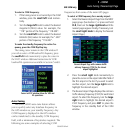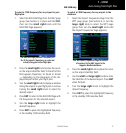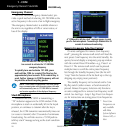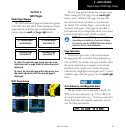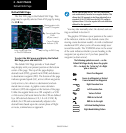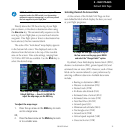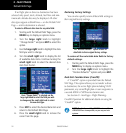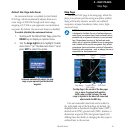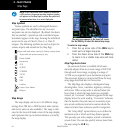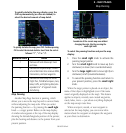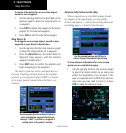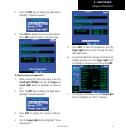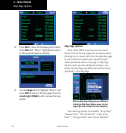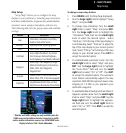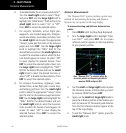
2 - NAV PAGES
33
190-00357-00 Rev E
Map Page
Default Nav Page Auto Zoom
AnautozoomfeatureisavailablefortheDefault
NAVPage,whichautomaticallyadjustsfromanen
route range of 200 NM through each lower range,
stopping at 5.0 NM as you approach your destination
waypoint. By default, the autozoom feature is disabled.
To enable (disable) the autozoom feature:
1. Starting with the Default NAV Page, press the
MENU key to display an options menu.
2. Turn the large right knob to highlight “Enable
Auto Zoom?” (or “Disable Auto Zoom?”) and
press ENT to select this option.
Autozoom automatically adjusts the map
range as you approach your destination
waypoint.
Map Page
ThesecondNAVpageisthemappage,whichdis-
plays your present position using an airplane symbol,
along with nearby airports, navaids, user-defined
waypoints, airspace boundaries, lakes, rivers, high-
ways and cities.
NOTE: The electronic chart is an aid to navigation and
is designed to facilitate the use of authorized govern-
ment charts, not replace them. Land and water data is
provided only as a general reference to your surround-
ings. The positional accuracy of the land and water
data is not of a precision suitable for use in navigation
and it should not be used for navigation. Only official
government charts and notices contain all information
needed for safe navigation – and, as always, the user is
responsible for their prudent use.
The Map Page is the second of the Nav pages
(six, or more, if equipped with weather,
traffic, radar, or other systems). The map
range is depicted in the lower left corner and
adjusted with the RNG key.
Map Display
Map Range
Present
Position
Desired
Track
Second Page in
NAV Group
Data Fields
Five user-selectable data fields can be added to
the right-hand side of the Map Page. By default, the
displayed data is destination waypoint name (WPT),
desiredtrack(DTK),groundtrack(TRK),distanceto
destinationwaypoint(DIS)andgroundspeed(GS).
Adding these data fields or changing the data types is
outlined later in this section.



